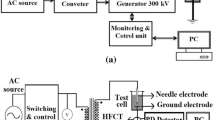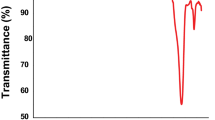Abstract
The extensive use of mineral oil for high voltage insulation applications has directed to widespread research works targeted at improving its dielectric and thermal characteristics. The present study investigates a novel nanofluid insulation prepared using carbon quantum dots (CQD) which is used for the surface treatment of SiO2 nanoparticles added to commercially available mineral oil. The proposed nanofluid referred as CQD–SiO2 nanofluid is tested for its insulation properties such as AC breakdown voltage (BDV), partial discharge (PD), lightning impulse (LI), dissipation factor (Tan-delta), volume resistivity, viscosity and thermal characteristics such as flash and fire point. The tests were conducted for three different nanofluid concentrations, that is, 0.01%wt, 0.05%wt and 0.1%wt. Weibull distribution analysis is carried out for breakdown data of BDV test and LI test. Results of CQD–SiO2 nanofluid are compared with mineral oil with and without SiO2 nanofillers. The results show that inclusion of CQD covered SiO2 nanoparticles have the capability to improve the AC breakdown strength by more than 100%, partial discharge inception voltage by 50%, lightning impulse withstand capabilities up to 20% and volume resistivity by 50%. It has also the tendency to slightly improve the flash point and fire point properties than the mineral oil. Significant reduction of PD magnitude and Tan-delta values are noticed with CQD–SiO2 nanofluid. Such results indicate that the CQD–SiO2 nanofluid can be a suitable candidate for MV insulation applications.













Similar content being viewed by others
References
Rouse TO (1998) Mineral insulating oil in transformers. IEEE Electr Insul Mag 14(3):6–16
Chandrasekar S, Montanari GC (2014) Analysis of partial discharge characteristics of natural esters as dielectric fluid for electric power apparatus applications. IEEE Trans Dielectr Electr Insul 21(3):1251–1259
Cavallini A, Chen X, Montanari GC, Ciani F (2010) Diagnosis of EHV and HV transformers through an innovative partial-discharge-based technique. IEEE Trans Pow Deliv 25(2):814–824
Pompili M, Mazzetti C, Forster EO (1992) Partial discharge distributions in liquid dielectrics. IEEE Trans Electr Insul 27:99–105
Senthilkumar S, Karthik B, Chandrasekar S (2014) Investigations on PD characteristics of thermal aged palm and corn oil for power transformer insulation applications. J Electr Eng Technol 9(5):1660–1669
Lv YZ, Zhou Y, Li CR, Wang Q, Qi B (2014) Recent progress in nanofluids based on transformer oil: preparation and electrical insulation properties. IEEE Electr Insul Mag 30(5):23–32
Jin H, Morshuis PHF, Mor AR, Smit JJ, Andritsch T (2015) Partial discharge behavior of mineral oil based nanofluids. IEEE Trans Dielectr Electr Insul 22(5):2747–2753
Nagendran S, Chandrasekar S (2018) Investigations on partial discharge, dielectric and thermal characteristics of nano SiO2 modified sunflower oil for power transformer applications. J Electr Eng Technol 13(3):1337–1345
Cavallini A, Karthik R, Negri F (2015) The effect of magnetite graphene oxide and silicone oxide nanoparticles on dielectric withstand characteristics of mineral oil. IEEE Trans Dielectr Electr Insul 22(5):2592–2600
Jin H, Morshuis PHF, Smit JJ, Andritsch T (2014) The effect of surface treatment of silica nanoparticles on the breakdown strength of mineral oil. In: Proceedings of IEEE international conference on dielectric liquids, pp 1–4
Li J, Zhang Z, Zou P, Grzybowski S, Zahn M (2012) Preparation of a vegetable oil-based nanofluid and investigation of its breakdown and dielectric properties. IEEE Electr Insul Mag 28(5):43–50
Peppas GD, Charalampakos VP, Pyrgioti EC (2016) Statistical investigation of AC breakdown voltage of nanofluids compared with mineral and natural ester oil. IET Sci Meas Technol 10:644–652
Uthirakumar P, Devendiran M, Yuna JH, Kima GC, Kalaiarasan S, Leea IH (2018) Role of carbon quantum dots and film thickness on enhanced UV shielding capability of flexible polymer film containing carbon quantum dots/Ndoped ZnO nanoparticles. Opt Mater 84:771–777
Uthirakumar P, Muthulingam S, Khan R, Dao VD, Tran VH, Lee IH (2015) Carbon quantum dots decorated leaf-like CuO nanosheets and their improved dispersion for an excellent UV-shielding properties in polymer films. RSC Adv 5:71968–71972
Chandrasekar S, Uthirakumar AP (2018) Carbon quantum dots covered nano dielectric fluids and its preparation methods thereof. Indian Patent Ref. No. 201841031593
Montanari GC, Cacciari M (1991) Estimating the cumulative probability of failure data points to be plotted on Weibull and other probability papers. IEEE Trans Electr Insul 26(6):1224–1229
Lu Y-Z, Zhang SN, Du Y-F, Chen MT, Li CR (2013) Effect of oleic acid surface modification on dispersibility of TiO2 nanoparticles in transformer oils. J Inorg Mater 28(6):594–598
Viali WR, Alcantara GB, Sartoratto PPC et al (2010) Investigation of the molecular surface coating on the stability of insulating magnetic oils. J Phys Chem 114(1):179–188
Dey D, Kumar P, Samantaray S (2017) A review of nanofluid preparation, stability, and thermo-physical properties. Heat Transf Asian Res 46(8):1413–1442
Yu W, Xie H (2012) A review on nanofluids: preparation, stability mechanisms, and applications. J Nanomater vol 2012, Article ID 435873
Bushehri MK, Mohebbi A, Rafsanjani HH (2016) Prediction of thermal conductivity and viscosity of nanofluids by molecular dynamics simulation. J Eng Thermophys 25(3):389–400
Arthur O, Karim MA (2016) An investigation into the thermophysical and rheological properties of nanofluids for solar thermal applications. Renew Sustain Energy Rev 55:739–755
Uthirakumar P, Devendiran M, Kim TH, Lee I-H (2018) A convenient method for isolating carbon quantum dots in high yield as an alternative to the dialysis process and the fabrication of a full-band UV blocking polymer film. New J Chem 42:18312–18317
Muthulingam S, Lee I-H, Uthirakumar P (2015) Highly efficient degradation of dyes by carbon quantum dots/N-doped zinc oxide (CQD/N-ZnO) photocatalyst and its compatibility on three different commercial dyes under daylight. J Colloid Interface Sci 455:101–109
Muthulingam S, Bae KB, Khan R, Lee I-H, Uthirakumar P (2015) Improved daylight-induced photocatalytic performance and suppressed photocorrosion of N-doped ZnO decorated with carbon quantum dots. RSC Adv 5:46247–46251
Acknowledgements
Author (S.C) would like to sincerely thank Department of Science and Technology (DST) (Grant No. SR/NM/NT-1051/2016 (G) dt.15.03.2018), Govt. of India, New Delhi for funding this research project work under Nano Mission Scheme.
Author information
Authors and Affiliations
Corresponding author
Additional information
Publisher's Note
Springer Nature remains neutral with regard to jurisdictional claims in published maps and institutional affiliations.
Rights and permissions
About this article
Cite this article
Chandrasekar, S., Kasi Viswanathan, P., Uthirakumar, P. et al. Investigations on Novel Carbon Quantum Dots Covered Nanofluid Insulation for Medium Voltage Applications. J. Electr. Eng. Technol. 15, 269–278 (2020). https://doi.org/10.1007/s42835-019-00316-5
Received:
Revised:
Accepted:
Published:
Issue Date:
DOI: https://doi.org/10.1007/s42835-019-00316-5




